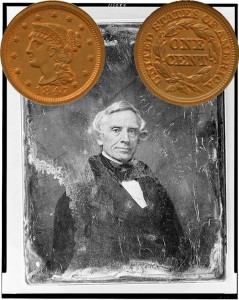Today the Large Cent Coin helps tell the story of how Miss Annie Ellsworth sent the first telegraph message 171 years ago.
The Telegraph Manual by Taliaferro Preston Shaffner published in 1867 describes the efforts of Professor Samuel F. B. Morse and his telegraph machine.
In April 1838, the Congressional Committee on Commerce favorably approved Professor Morse’s idea, but it would be a couple of years before Congress would grant funds for his efforts.
=====
It is believed by the committee that the subject is one of such universal interest and importance, that an early action upon it will be deemed desirable by Congress, to enable the inventor to complete his trial of the invention upon the extended scale contemplated, in season to furnish Congress with a full report of the result during its present session, if that shall be practicable.
All which is respectfully submitted. Francis O. J. Smith, Jas. M. Mason, S. C. Phillips, John T. H. Worthington, Samuel Cushman, Wm. H. Hunter, John I. DeGraff, George W. Toland, Edward Curtis, – Committee on Commerce, U. S. H. R.
Nothing further was effected at that session of Congress, and but little hope was entertained that Congress would ever grant the desired appropriation. Mr. F. O. J. Smith was so well convinced of the practicability of the system of telegraph, that he abandoned his seat in Congress, and purchased one quarter interest in the invention for Europe and America, under date of March, 1838.
In May, 1838, Professor Morse and Mr. Smith visited Europe to obtain patents and to make sales of the invention. In England a patent was refused, because a brief description of the invention had been published. In France a patent was granted, but by order of the government he was forbidden to put it in operation, and at the end of two years the patent expired. The various efforts in Europe proved of no avail.
In June, 1840, Professor Morse obtained his patent in the United States, based on the specification filed by him in April, 1838. In December, 1842, he petitioned Congress again for aid to test the practicability of his invention, and on the 30th of December the Committee on Commerce reported a bill in favor of appropriating $30,000 for that purpose.
The bill passed the House of Representatives, and in the last hour of the last night of the last session of that Congress, March 3d, 1843, the bill passed the Senate, was signed by the President, and became a law.
CONSTRUCTION OF THE EXPERIMENTAL LINE.
The experimental line between Washington and Baltimore was placed under course of construction in 1843. It was attempted to make it subterranean.
Two copper wires, covered with cotton and gum-lac, were drawn through a leaden tube. From Baltimore to the Relay House, nine miles, were thus laid in the earth.
On testing it an earth circuit was found; not even a mile of it could be worked.
The plan proved a failure. Professor Morse then, after consultation with his friends, determined to put the wires on poles. The same copper wire that had been drawn through the leaden tubes for much of the distance between Baltimore and Washington were taken from the tubing and stretched on poles.
In May, 1844, the line was completed between those cities, and on the 27th day of May the first dispatch was transmitted over the line from Washington to Baltimore.
It fell to the lot of Miss Annie Ellsworth to send that dispatch, which was, “What hath God wrought?” As manipulating assistants, Professor Morse had Mr. Alfred Vail and Mr. L. F. Zantzinger, the former is no more, and the latter still remains attached to the profession of practical telegraphing, and is the oldest now in the service.
The apparatuses used were large and weighty. The electromagnet weighed one hundred and eighty-five pounds, and its bulky construction made it necessary for two men to handle it whenever it had to be moved.
This monster form of magnet was continued for a short time, and replaced by another less in size, devised by Professor Charles G. Page. These latter remained in the service until substituted by some of the size now in use, which had been purchased by Professor Morse in France in the year 1845.
=====
The Large Cent Coin shows against an image of Professor Samuel F. B. Morse, circa 1844.
